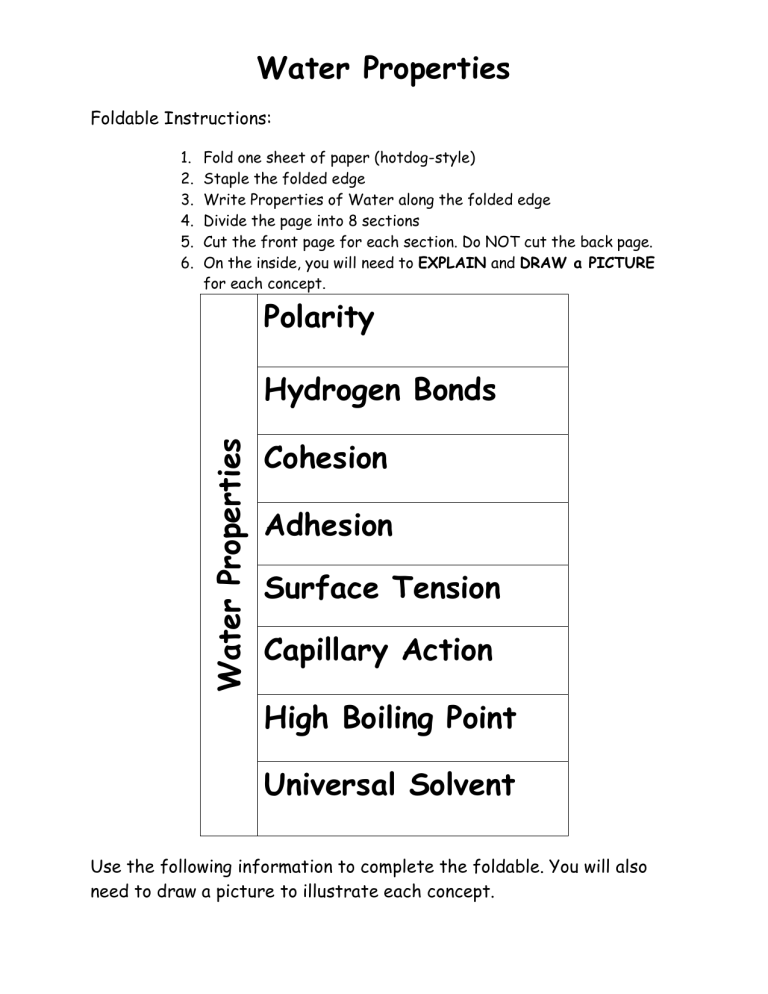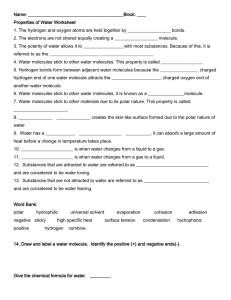
Water Properties Foldable Instructions: 1. 2. 3. 4. 5. 6. Fold one sheet of paper (hotdog-style) Staple the folded edge Write Properties of Water along the folded edge Divide the page into 8 sections Cut the front page for each section. Do NOT cut the back page. On the inside, you will need to EXPLAIN and DRAW a PICTURE for each concept. Polarity Water Properties Hydrogen Bonds Cohesion Adhesion Surface Tension Capillary Action High Boiling Point Universal Solvent Use the following information to complete the foldable. You will also need to draw a picture to illustrate each concept. Water Properties Polarity: All of water’s unique physical properties are caused by water’s polarity. Polarity is the uneven distribution of charge on a molecule. One side will have a positive charge and the other side will have a negative charge because they do not share the electrons equally. Hydrogen Bonds: Polar molecules, such as water molecules, have a weak, partial negative charge at one region of the molecule (the oxygen atom in water) and a partial positive charge elsewhere (the hydrogen atoms in water). So when water molecules are close together, opposites attract (their positive regions are attracted to the negative regions of nearby molecules & vise versa). The force of attraction, shown here as a dotted line, is called a hydrogen bond. Each water molecule is hydrogen bonded to four others. Water Properties Cohesion: Water molecules stick to each other. This is caused by hydrogen bonds that form between the slightly positive and negative ends of neighboring molecules. This is the reason why water is found in drops; perfect spheres. It’s hard to imagine water behaving any other way. Adhesion: Water molecules stick to other surfaces. This causes water to move upward against gravity in plant stems and to be absorbed by paper towels. It also causes water to adhere to spider webs. Surface Tension: Water has the ability to support small objects. The hydrogen bonds between neighboring molecules cause a “film” to develop at the surface. Water Properties Capillary Action: Water has the ability to “climb” structures. Think about what happens when you stick the tip of a straw in a glass of water or dip a paper towel in a puddle. Because water molecules stick together (cohesion) and to other substances (adhesion), they are able to travel against the pull of gravity. Boiling Point: Water has a high boiling point. Water is one of the few substances that remain a liquid at such a large range of temperatures (O-100 °C). A large amount of energy must be invested to overcome the hydrogen bonds in liquid water to change it to the gas phase. Water Properties Universal Solvent: Water is able to dissolve a wide variety of substances so it is considered to be the universal solvent. More substances will dissolve in water than any other liquid. This includes other polar substances (such as sugar) and ionic compounds (such as salt). When a sugar crystal is placed in water, the slightly positive and negative ends of the water molecule attract the sugar molecules in the crystal (they are also polar) and pull them into solution.





